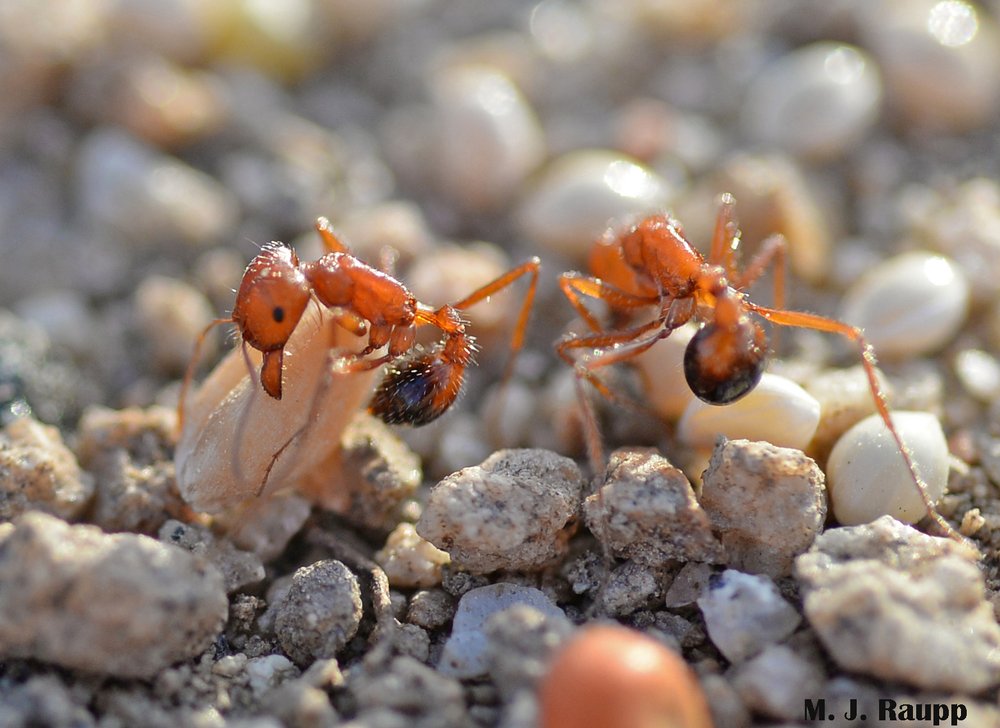Gathering seeds and carrying tiny boulders in the desert: Harvester ants, Pogonomyrmex spp.

Harvester ants grapple with bird seed placed just outside their nest in the Mojave Desert.
With weather still a bit dreary in the DMV, let’s travel to the Mojave Desert in southern California to warm up and meet some really cool desert denizens, harvester ants. In previous episodes we visited home-invading odorous house ants as they raided pantries in search of sweets and herded honeydew-squirting aphids on peony blossoms outdoors. Unlike many ants that carbo-load on nectar and honeydew, harvester ants thrive on long chain and complex carbohydrates, lipids, and proteins found in the seeds of plants. These ambitious foragers get their name by harvesting seeds that serve as the major source of food for their colony. Red harvester ants greet the day by sending patrollers from the hidden depths of the colony to inspect the area immediately around the colony and beyond to distances up to a 20-minute ant-walk away. The return of patrollers signals the colony to muster forager ants to begin the busy task of collecting seeds from nearby plants. These dauntless workers may spend up to an hour on their journeys and venture 20 meters from the colony to collect seeds and bring them back to subterranean granaries in their colony.
On a sandy road in the Mojave Desert, a colony of harvester ants works at a fevered pitch. Watch as they collect seeds for their granary and excavate sand to enlarge their subterranean home. Harvester ants play a key role in dispersing seeds of many plants in the high desert.
Seed harvesting is not entirely bad for desert plants as some seeds are lost along the way home during peregrinations of foragers. Some accounts tell of seeds sprouting in over-filled harvester ant galleries, giving rise to new desert plants. Either way, harvester ants are important seed dispersal agents for propagules of many different species of plants. In fact, some plants have taken this relationship to a higher level and produce seeds with elaiosomes, structures packed with lipids, proteins, vitamins, and other nutrients that are highly attractive to ants. This form of ant-assisted seed-dispersal is known as myrmecochory. Why would plants make an evolutionary investment to manufacture energy-rich dispersal structures for their seeds? Scientists provide evidence that seed-dispersal by ants may reduce competition between parental plants and their offspring or competition between their offspring and other species of plants. Dispersing seeds may also derail gluttonous seed-eaters like small mammals that might devour an entire crop of seeds concentrated beneath a parental plant. Also, ant colonies often occupy nutrient rich pockets of soil where plants can thrive. Convincing ants to carry their seeds to these favorable microhabitats is a clever move on the part of a plant.
Red harvester ants are known by many as the entertaining occupants of “ant farms” sold to children and schools. Ant farms are engaging and educational but, as some have learned firsthand, harvester ants can pack a memorable sting. On the famous and amusing Schmidt sting pain index, pain associated with the sting of red harvester ants is described as “Like using a drill to excavate your ingrown toenail.” Yikes! Having said this, I will share that as I photographed and recorded harvester ants for this episode, dozens of ants explored my hands, arms, and body without delivering a bite or sting. Lucky me, I guess.
Acknowledgements
We thank our hosts Robin and Max at the High Desert Eden for sharing their harvester ants, stars of this episode. Two remarkable references, “The Regulation of Foraging Activity in Red Harvester Ant Colonies” by Deborah M. Gordon, and “The Ants” by Bert Hölldobler and E. O. Wilson, were used to prepare this episode.
This post appeared first on Bug of the Week